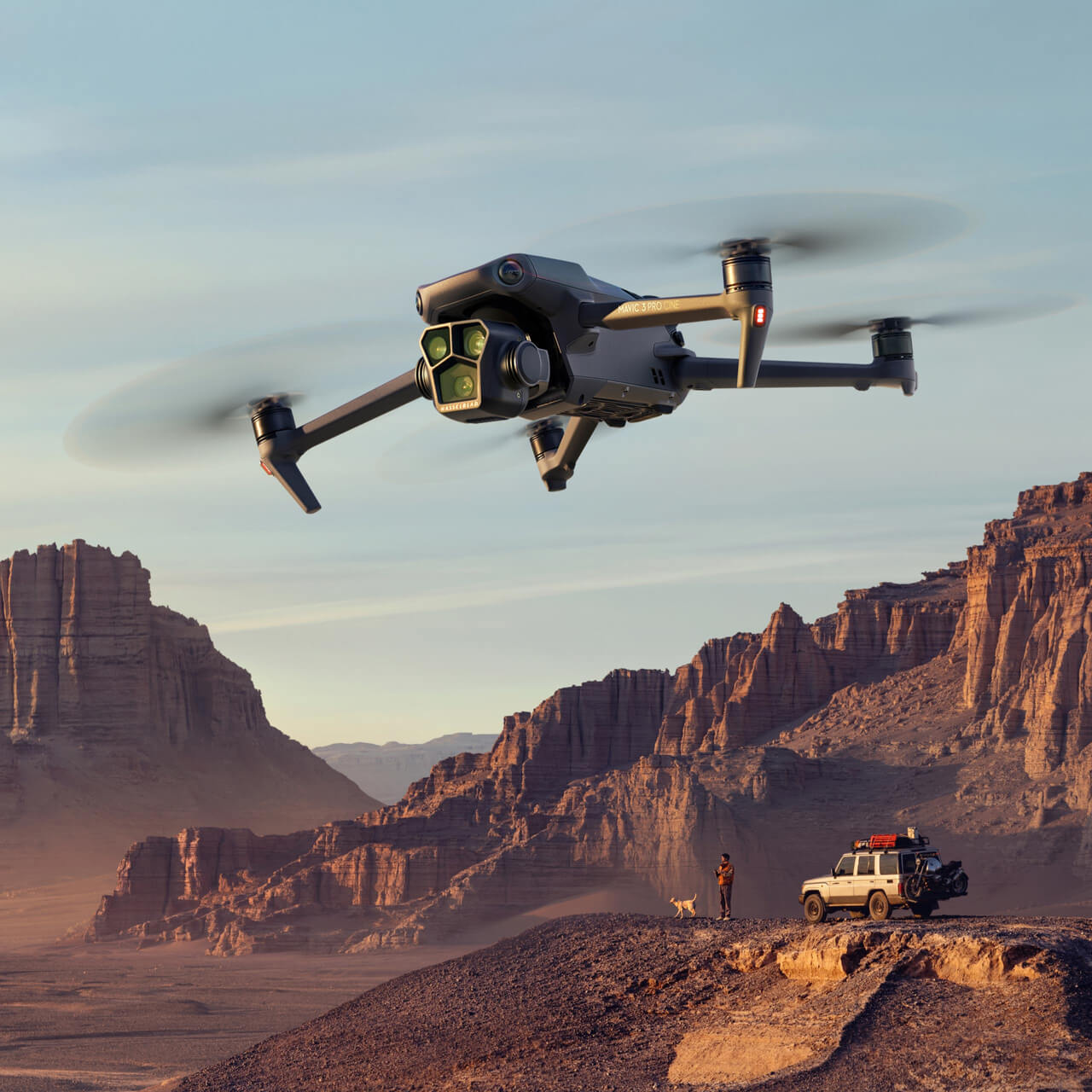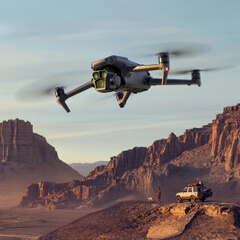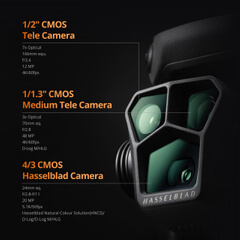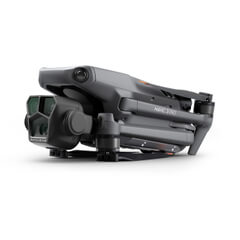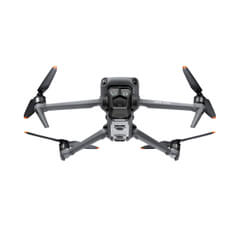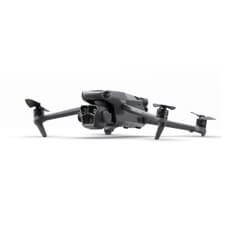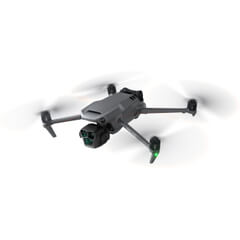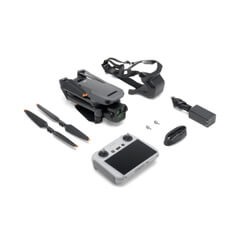DJI Mavic 3 Pro (DJI RC)
Select Option
Take a Closer Look
Flagship Tri-Camera System
With a 4/3 CMOS Hasselblad camera, a 70mm tele camera, and a 166mm tele camera, Mavic 3 Pro helps you create stunning works in various scenarios.
4/3 CMOS Hasselblad Camera
The Hasselblad camera shoots 5.1K/50fps and 4K/120fps [1] with a f/2.8 - f/11 range. The 10-bit D-Log M mode records up to one billion colors.
Apple ProRes for Pro Creation
Mavic 3 Pro Cine has triple camera Apple ProRes codec support. It also has a built-in 1TB SSD [2] and a 10Gbps lightspeed data cable.
43-Min Max Flight Time [3]
Mavic 3 Pro gives you more confidence to fly further while enjoying aerial photography creation. Execute every step during a single flight.
Omnidirectional Obstacle Sensing [4]
Mavic 3 Pro allows you to fly even in complex environments. Eight sensors and powerful computing engine sense obstacles and plan a safe route.
15km HD Video Transmission [5]
DJI O3+ supports a transmission distance of up to 15 km and 1080p/60fps live feed, for smoother control.
Thrilling Immersive Flight
Experience immersive FPV when you use DJI goggles along with the DJI RC Motion 2[6]. Enjoy true-to-life colors, accurate details, and motion controls that make flying captivating.
In the Box
DJI Mavic 3 Pro
× 1
DJI RC
× 1
DJI Mavic 3 Series Intelligent Flight Battery
× 1
DJI Mavic 3 Series Low-Noise Propellers (Pair)
× 3
DJI 65W Portable Charger
× 1
DJI Mavic 3 Pro Storage Cover
× 1
USB 3.0 Type-C Cable
× 1
DJI RC Spare Control Sticks (pair)
× 1
Moments By You
Which is the Best for You?
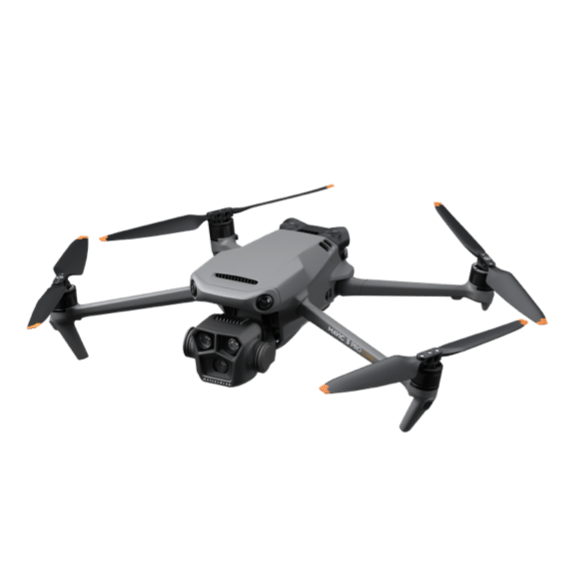
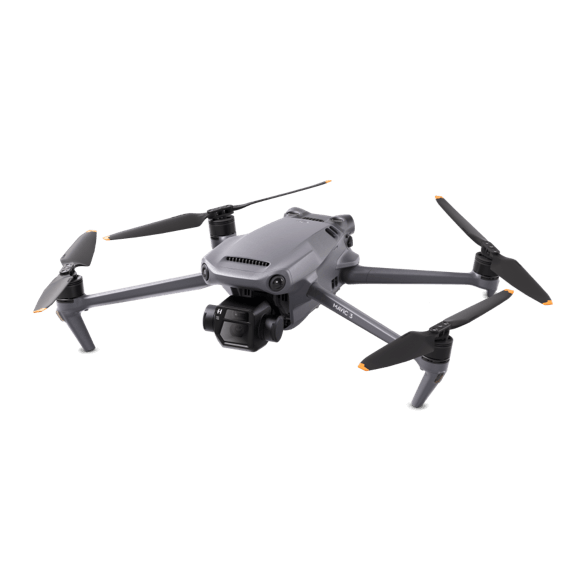
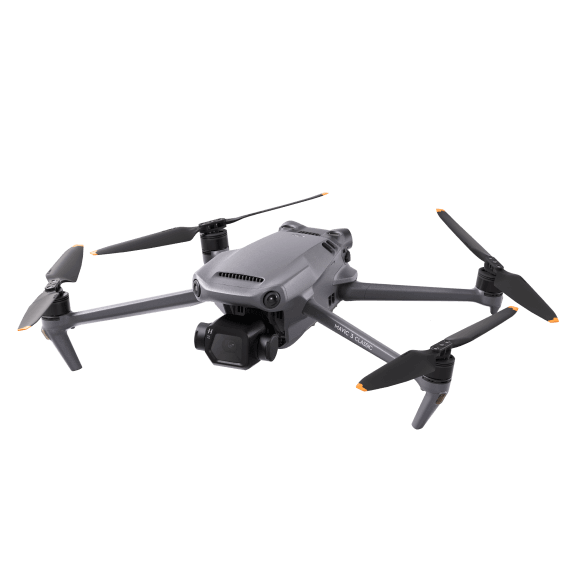
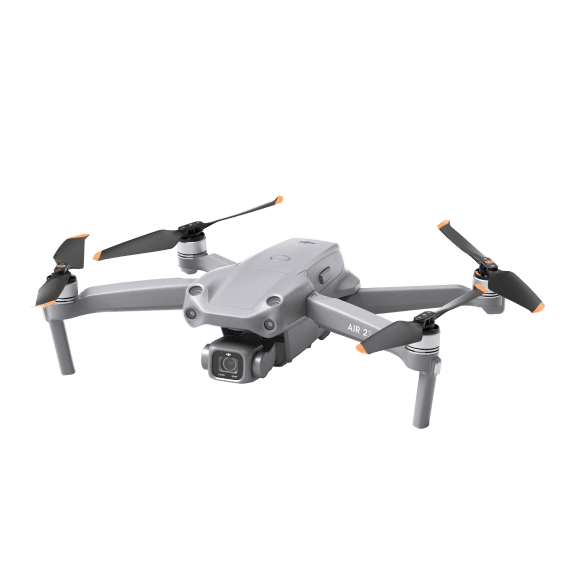
From 2 199 €
759 €
From 1 599 €
From 799 €
 4/3 CMOS Hasselblad Camera1/1.3″ CMOS Medium Tele Camera1/2″ CMOS Tele Camera
4/3 CMOS Hasselblad Camera1/1.3″ CMOS Medium Tele Camera1/2″ CMOS Tele Camera 4/3 CMOS Hasselblad Camera1/2″ CMOS Tele Camera
4/3 CMOS Hasselblad Camera1/2″ CMOS Tele Camera 4/3 CMOS Hasselblad Camera
4/3 CMOS Hasselblad Camera 1'' CMOS
1'' CMOSMedium Tele/Tele Camera: 4K/60fps
Medium Tele/Tele Camera: 4K/60fps
DCI 4K/120fps
4K/60fps
Medium Tele Camera: D-Log M/HLG/Normal
Tele Camera: D-Log M/HLG/Normal
Tele Camera: Normal
 Omnidirectional Obstacle Sensing
Omnidirectional Obstacle Sensing Omnidirectional Obstacle Sensing
Omnidirectional Obstacle Sensing Omnidirectional Obstacle Sensing
Omnidirectional Obstacle Sensing Obstacle Sensing in 4 Directions
Obstacle Sensing in 4 Directions DJI O3+ 15km,
DJI O3+ 15km, 1080p/60fps Transmission
 DJI O3+ 15km,
DJI O3+ 15km, 1080p/60fps Transmission
 DJI O3+ 15km, 1080p/60fps Transmission
DJI O3+ 15km, 1080p/60fps Transmission DJI O3 12km,
DJI O3 12km, 1080p/30fps Transmission
 Max Takeoff Altitude
Max Takeoff Altitude Max Takeoff Altitude
Max Takeoff Altitude Max Takeoff Altitude
Max Takeoff Altitude Max Takeoff Altitude
Max Takeoff AltitudeUnderstand the Triple-Camera Imaging System With One Picture
Let’s Answer Your Questions
Is it necessary to upgrade to the Mavic 3 Pro Series if I already have a Mavic 3 or Mavic 3 Classic?
Compared with Mavic 3 and Mavic 3 Classic, we've significantly upgraded the imaging performance of the Mavic 3 Pro Series:
The Mavic 3 Pro Series includes DJI’s first tri-camera flagship drones with multiple focal lengths. It uses the same wide-angle 4/3 CMOS Hasselblad camera as Mavic 3 and Mavic 3 Classic. Compared with Mavic 3, it adds a 1/1.3-inch CMOS 70mm medium tele camera with 48MP effective pixels. It also has an upgraded 1/2-inch CMOS 166mm tele camera with 12MP effective pixels, providing more flexible aerial photography perspectives while enhancing creative efficiency and freedom.
All three cameras of the Mavic 3 Pro Series drones support shooting 4K/60fps video, and all three cameras of the Cine version support Apple ProRes 422/422 HQ/422 LT codecs. No matter which version you choose, you will enjoy high-level professional creation.
If you need more focal length options, better creative effects, and work that has more expressive composition and storytelling details, the Mavic 3 Pro Series is here to meet your shooting needs.
In addition, the Mavic 3 Pro Series also supports the Hasselblad Natural Colour Solution (HNCS), D-Log, D-Log M, HLG, and other color modes, which retain more image details and facilitate more efficient color grading in post-production.
What are some use cases for the new 70mm medium tele camera of the Mavic 3 Pro Series?
The 70mm medium tele camera is equipped with a 1/1.3″ CMOS sensor. Compared with the wide-angle Hasselblad camera, the 70mm medium tele camera captures footage with a stronger sense of spatial compression, which can better capture the relationship between the subject and the surroundings, highlight the subject in a complex environment, and create a visual focus in the image or video. Additionally, the medium tele camera supports Night video mode (Night Shots), presenting brilliant nighttime scenes at a 70mm focal length.
Compared with the 166mm tele camera, using the medium tele camera may be better in some scenarios. It enables new aerial photography perspectives and can help to achieve different camera movements. You don't need to replace the camera on the drone during shooting. Just tap the screen to switch between different focal lengths, making transitions smoother and more natural.
The medium tele camera supports a 3x optical zoom and the new D-Log M color mode, further reducing the difficulty of color grading in post-production. It also supports FocusTrack, Hyperlapse, and 3x-7x digital zoom to help you create cinematic footage effortlessly.
What are the advantages of the 166mm tele camera?
The upgraded tele camera features higher resolution and a wider f/3.4 aperture. It supports shooting 4K/60fps video with 7x optical zoom and 12MP photos. The hybrid zoom reaches up to 28x. Zoom in and immerse your image in rich details. The tele camera also supports HLG and 10-bit D-Log M color modes, enabling greater flexibility in post-production.
What differentiates Mavic 3 Pro Cine from Mavic 3 Pro? How should I choose?
The Mavic 3 Pro Series includes two versions: Mavic 3 Pro and Mavic 3 Pro Cine.
Mavic 3 Pro inherits DJI’s flagship imaging and flight performance. It is portable, powerful, and suitable for photography enthusiasts, professional photographers, and film/television studios.
Mavic 3 Pro Cine boasts a built-in 1TB SSD and supports professional video encoding like Apple ProRes 422, Apple ProRes 422 HQ, and Apple ProRes 422 LT. It is a perfect choice for professional film/television production.
What are the differences between DJI RC and DJI RC Pro? How should I choose?
Both remote controllers come with a 5.5-inch HD screen, so you can power on and use them directly without the need to connect to a mobile device.
DJI RC Pro features a screen brightness of up to 1000 nits and supports the installation of third-party apps and the live stream function, allowing you to live stream the real-time camera view during flight.
DJI RC Pro is equipped with the latest-generation processor, offering stronger performance and lower power consumption. This results in 4x improved CPU performance, 7x improved GPU performance, and 20% lower power consumption over its predecessor. DJI RC Pro brings a more durable, stable, and smooth system that simply enhances flying.
Is the Fly More Combo worth buying?
If you purchase the Mavic 3 Pro Series for the first time, choosing the Fly More Combo is highly recommended.
Compared with Mavic 3 Pro (DJI RC), the Fly More Combo provides two additional Intelligent Flight Batteries and practical accessories like the Battery Charging Hub (100W) and the ND Filters Set (ND8/16/32/64). Whether for travel or professional shooting, the Fly More Combo can assist aerial photography, eliminating low battery anxiety and help you fully enjoy the creative process.
Does the DJI Mavic 3 Series support the DJI Goggles Series and the DJI Motion Controller Series?
The DJI Mavic 3 Series is only compatible with DJI Goggles 2, DJI Goggles Integra, and DJI RC Motion 2.
What precautions should be taken when using DJI Goggles Integra / DJI Goggles 2 with the DJI Mavic Series or DJI Mini Series for the first time?
1. Before first use, please make sure that the goggles and motion controller have been updated to the latest firmware version. Additionally, use DJI RC-N1, DJI RC, or DJI RC Pro to update the drone to the latest firmware version. Otherwise, the linking between the aircraft and the goggles and motion controller will fail.
2. FPV flight control is only supported when the goggles are used with DJI RC Motion 2.
3. When the goggles are used with the DJI Mavic 3 Series, the drone supports omnidirectional obstacle sensing and APAS 5.0, 4K/60fps and 1080p/60fps normal video recording, and Explore mode. For intelligent features like MasterShots, QuickShots, and Panorama, only DJI RC-N1, DJI RC, or DJI RC Pro are compatible.
4. When the goggles are used with DJI Mini 3 Pro, the drone supports forward and backward obstacle sensing and APAS 4.0, 4K/60fps, 2.7K/60fps, and 1080p/60fps normal video recording. For vertical shooting and intelligent features like MasterShots, QuickShots, and Panorama, only DJI RC-N1, DJI RC, or DJI RC Pro are compatible.
Does the DJI RC-N1 remote controller support the O3+ video transmission when used with the DJI Mavic 3 Series aircraft?
Yes.
1. Once linked with a DJI Mavic 3 Series aircraft, the DJI RC-N1 remote controller will automatically update the firmware if necessary. The DJI RC-N1 supports the O3+ video transmission like the DJI RC Pro and DJI RC.
2. In an unobstructed environment free of interference, these remote controllers can support a max transmission range of 15 km with FCC compliance.
3. These remote controllers support 1080p/60fps live feeds.
When used with different aircraft, These remote controllers will automatically select the corresponding firmware version for updating and support the following transmission technologies enabled by the hardware of the linked aircraft:
a. DJI Mini 3/DJI Mini 2/DJI Mavic Air 2: O2
b. DJI Mini 3 Pro/DJI Air 2S: O3
c. DJI Mavic 3 Series: O3+
Is the DJI Mavic 3 Pro Series compatible with accessories of DJI Mavic 3 or DJI Mavic 3 Classic?
The following accessories are currently compatible:
1. DJI RC
2. DJI RC Pro
3. DJI RC-N1
4. DJI Mavic 3 Series Intelligent Flight Battery
5. DJI Mavic 3 Series Low-Noise Propellers
6. DJI Mavic 3 Series Battery Charging Hub
7. DJI 65W Car Charger
8. DJI 65W Portable Charger
9. DJI Convertible Carrying Bag
10. DJI 10Gbps Lightspeed Data Cable
The following accessories are not compatible:
1. DJI Mavic 3 Storage Cover
2. DJI Mavic 3 Classic Storage Cover
3. DJI Mavic 3 Series Propeller Guard
4. DJI Mavic 3 Series Protector Case
5. DJI Mavic 3 ND Filters Set and DJI Mavic 3 Classic ND Filters Set
6. DJI Mavic 3 Wide-Angle Lens and DJI Mavic 3 Classic Wide-Angle Lens
Still have questions? Get help from a DJI expert.
1. ActiveTrack is unavailable at video resolutions higher than 4K or frame rates over 60fps.
2. Actual available storage space may be reduced due to system configuration. For details, please refer to the Specs page of Mavic 3 Pro on the official DJI website.
3. Flight Time was measured with Mavic 3 Pro flying at a constant speed of 32.4 kph in a windless environment at sea level until the battery level reached 0%. Data is for reference only. Please pay attention to RTH reminders in the DJI Fly app during your flight.
4. DO NOT use the aircraft in severe weather conditions, including heavy wind exceeding 13.8 m/s, snow, rain, fog, hail, or lightning. DO NOT fly the aircraft 6000 m (19685 ft.) or higher above sea level. DO NOT fly the aircraft in environments where the temperature is below -10° C (14° F) or above 40° C (104° F). DO NOT take off from moving objects such as cars or boats. DO NOT fly close to reflective surfaces such as water or snow. Otherwise, the vision system may not work correctly. When the GNSS signal is weak, fly the aircraft in environments with good lighting and visibility. Low ambient light may cause the vision system to function abnormally. DO NOT fly near areas with magnetic or radio interference. Familiar magnetic or radio interference sources include Wi-Fi hotspots, routers, Bluetooth devices, high-voltage lines, large-scale power transmission stations, radar stations, mobile base stations, and broadcasting towers. Avoid sand entering the aircraft when taking off in desert or beach areas. Fly the aircraft in open areas away from crowds. Buildings, mountains, and trees may block the GNSS signal and affect the onboard compass.
5. Measured in an outdoor, open environment, without interference, and with FCC compliance. The above data shows the farthest communication range for one-way, non-return flights. Please pay attention to RTH reminders in the DJI Fly app during your flight.
6. Compatible with DJI Goggles Integra Motion Combo and DJI Goggles 2 Motion Combo, which are sold separately.
